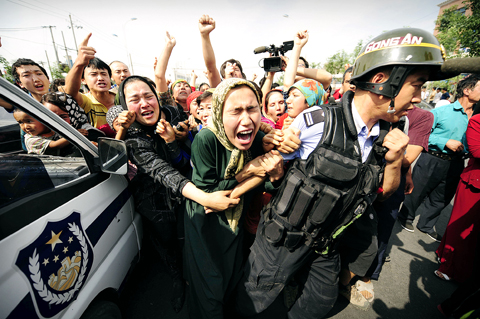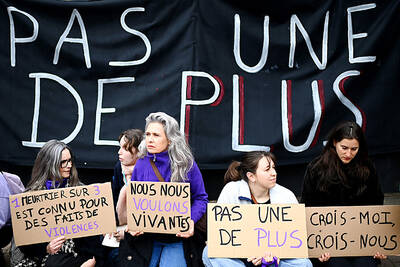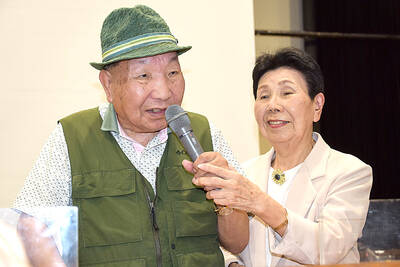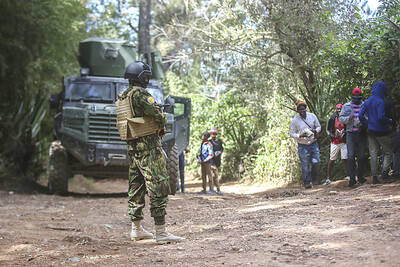Riots in China’s restless Xinjiang Uighur Autonomous Region are nothing new.
In 1990, 50 people were killed in the town of Baren when armed police put down a demonstration against Chinese rule by 3,000 disgruntled Muslims.
In 1997, members of the region’s ethnic Uighur population gathered in the city of Gulja to protest against the execution of 30 activists who had been campaigning for an independent East Turkestan. After two days of demonstrations, Chinese riot police moved in. The official death toll was put at nine, but some Western observers say as many as 400 people died.

PHOTO: AFP
Early reports following Sunday’s riot in Urumqi, the capital of Xinjiang, estimated that 140 people were killed and more than 800 injured when police and soldiers broke up a peaceful demonstration by Uighurs, which quickly turned violent. The riot, in which Han civilians were attacked, cars overturned and shops set on fire, has been described as the most bloody since the Tiananmen Square massacre of 1989.
More so even than Tibet, Xinjiang is the jewel in the crown of the People’s Republicof China. A strategic buffer between China and the former Soviet republics, it accounts for a sixth of China’s land mass and is rich in oil and gas deposits. The Chinese Communist Party is anxious, to the point of paranoia, that a coherent separatist movement will lead to an independent Xinjiang and thus to the fracturing of the country.
For this reason, it will stop at nothing to suppress Uighur dissent. If history is anything to go by, the next six months will be a desperate period for the Uighurs. In the wake of the Baren incident, every male in the area between the age of 13 and 60 was arrested. After the riots in Gulja, so many Muslim men were taken into custody the authorities were obliged to move them to a sports stadium on the outskirts of the city.
Amnesty International said the prisoners were hosed down with water cannons and had to live without shelter for several days. It was mid-winter. Many lost their hands and fingers to frostbite. The alleged ringleaders of the Gulja uprising were driven through the streets of the city in open trucks en route to a mass sentencing rally. Witnesses reported they appeared drugged and were beaten by their captors in full view of the crowd.
During this period, house-to-house searches became commonplace across Xinjiang. Curfews were imposed and foreign journalists barred from entering the region. A similar picture emerged in Tibet after last year’s riots. Monastery towns were sealed off and mass arrests carried out. About 1,200 Tibetans seized during this period are still unaccounted for by their families. Beijing blamed Tibetan spiritual leader the Dalai Lama for instigating the riots. It came as no surprise, therefore, to learn that last Sunday’s events in Urumqi have been blamed on Rebiya Kadeer, the businesswoman who lives in the US and is regarded by the Uighur community as a ruler-in-exile.
The Uighurs and their Han rulers are engaged in a cycle of violence and despair that shows no sign of abating.
In recent weeks, tensions between them were running high because of the seemingly heedless destruction of the old city of Kashgar. Buildings of enormous historical and cultural significance are being torn down to make way for highways and apartment blocks that symbolize the Chinese economic miracle. Uighur families who have lived in Kashgar for decades are being forcibly evicted to new homes on the outskirts of the city.
The frustration and resentment felt by most Uighurs at China’s crass insensitivity boiled over last Sunday. It can only be hoped that the continued suppression of Uighurs does not drive its more radical elements into the hands of ideologues and fanatics.

A French-Algerian man went on trial in France on Monday for burning to death his wife in 2021, a case that shocked the public and sparked heavy criticism of police for failing to take adequate measures to protect her. Mounir Boutaa, now 48, stalked his Algerian-born wife Chahinez Daoud following their separation, and even bought a van he parked outside her house near Bordeaux in southwestern France, which he used to watch her without being detected. On May 4, 2021, he attacked her in the street, shot her in both legs, poured gasoline on her and set her on fire. A neighbor hearing

DEATH CONSTANTLY LOOMING: Decades of detention took a major toll on Iwao Hakamada’s mental health, his lawyers describing him as ‘living in a world of fantasy’ A Japanese man wrongly convicted of murder who was the world’s longest-serving death row inmate has been awarded US$1.44 million in compensation, an official said yesterday. The payout represents ¥12,500 (US$83) for each day of the more than four decades that Iwao Hakamada spent in detention, most of it on death row when each day could have been his last. It is a record for compensation of this kind, Japanese media said. The former boxer, now 89, was exonerated last year of a 1966 quadruple murder after a tireless campaign by his sister and others. The case sparked scrutiny of the justice system in

DITCH TACTICS: Kenyan officers were on their way to rescue Haitian police stuck in a ditch suspected to have been deliberately dug by Haitian gang members A Kenyan policeman deployed in Haiti has gone missing after violent gangs attacked a group of officers on a rescue mission, a UN-backed multinational security mission said in a statement yesterday. The Kenyan officers on Tuesday were on their way to rescue Haitian police stuck in a ditch “suspected to have been deliberately dug by gangs,” the statement said, adding that “specialized teams have been deployed” to search for the missing officer. Local media outlets in Haiti reported that the officer had been killed and videos of a lifeless man clothed in Kenyan uniform were shared on social media. Gang violence has left

US Vice President J.D. Vance on Friday accused Denmark of not having done enough to protect Greenland, when he visited the strategically placed and resource-rich Danish territory coveted by US President Donald Trump. Vance made his comment during a trip to the Pituffik Space Base in northwestern Greenland, a visit viewed by Copenhagen and Nuuk as a provocation. “Our message to Denmark is very simple: You have not done a good job by the people of Greenland,” Vance told a news conference. “You have under-invested in the people of Greenland, and you have under-invested in the security architecture of this